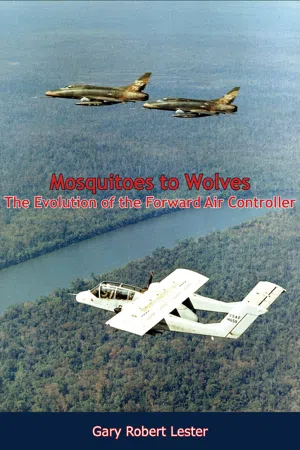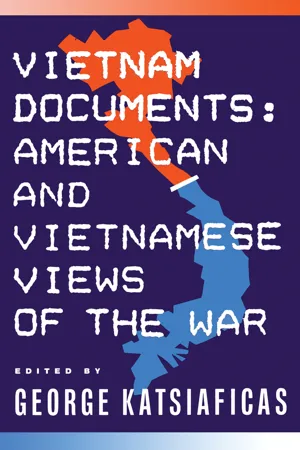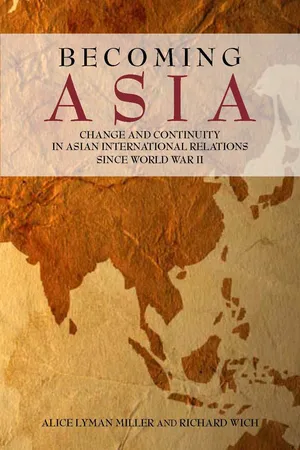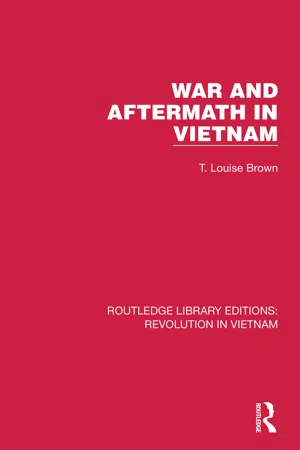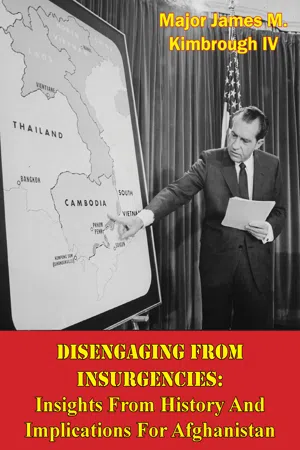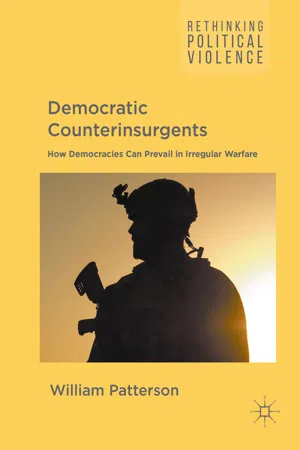History
Vietnamisation
Vietnamisation was a policy implemented by the United States during the Vietnam War, aiming to shift the burden of combat to the South Vietnamese forces and reduce American involvement. This strategy involved training and equipping the South Vietnamese military to take on a more active role in the conflict, while gradually withdrawing US troops.
Written by Perlego with AI-assistance
Related key terms
10 Key excerpts on "Vietnamisation"
- eBook - ePub
- Brigadier General James Lawton Collins Jr.(Author)
- 2014(Publication Date)
- Normanby Press(Publisher)
CHAPTER IV — Vietnamization, 1968-1972
Background
South Vietnam was the test case for implementing the Nixon doctrine and a new U.S. planning approach to Asia. Vietnamization was both a goal and the program through which that goal would be achieved at the earliest practical time. The constituent elements of Vietnamization--improvement and modernization of the South Vietnam armed forces, pacification, and combat operations--were inseparably interwoven, and the United States made every effort to maintain and strengthen their natural interdependence. Within the context of the situation in South Vietnam, Vietnamization referred only to that portion of the war effort engaged in by the United States and did not refer to the total war effort which the government of Vietnam had carried as a large and heavy burden for so many years.The 1968 Tet offensive aimed at inflicting a decisive defeat on allied military forces and at sparking popular uprisings against the South Vietnam government throughout the country. In a radical departure from his former strategy, the enemy brought his forces out of their cross-border sanctuaries, went to unprecedented lengths to assemble supplies and weapons, and infiltrated his local forces into the major cities and towns, while holding his main forces in reserve to exploit the anticipated uprisings. But the local Viet Cong units were expended in vain and the regulars fared no better. Only in Hue did the enemy succeed in holding out for more than a few days; in most areas, his guerrilla units and clandestine governments came out into the open only to be quickly destroyed. South Vietnamese units, including the territorial forces, stood firm and worked side by side with U.S. units to throw the enemy out of his objective areas. Far from weakening the government of Vietnam, the Tet attacks gave it a new unity and sense of purpose. It had suffered the enemy's worst attacks and survived. - eBook - ePub
Mosquitoes to Wolves
The Evolution of the Forward Air Controller
- Gary Robert Lester(Author)
- 2020(Publication Date)
- Barakaldo Books(Publisher)
Chapter 10—Vietnamization and American Withdrawal President Richard M. Nixon brought a new approach to the war: pursuit of victory while withdrawing ground troops. To accomplish this, he continued the dishonest policy of his predecessor, Lyndon B. Johnson. As a result, Nixon generated distrust, drove some elements of the antiwar movement into terrorism, and degraded the nation’s armed forces. Early in 1969, the commitment of American combat troops was reduced and the air war was stepped up by subterfuge. The ploy most commonly used was the “protective reaction strike”: American aircraft loaded with bombs and rockets would fly over North Vietnam, Cambodia, and Laos; at the first sign of hostile intent—detecting a radar being switched on, for example—they would unload their ordnance. Much of South Vietnam was heavily bombed, efforts to bomb the Ho Chi Minh trail were increased, and North Vietnam was regularly attacked up to 50 miles north of the demilitarized zone (DMZ). The bomb tonnage dropped on Southeast Asia from 1969-72 surpassed the American bombing effort in both major theaters in World War II. {508} During this period, attention turned to close air support (CAS) missions. {509} The objective of the 1968 Improvement and Modernization Program (Vietnamization) was to stabilize the war. The military rationale implicit in the “Nixon Doctrine” rested on the assumption that US airpower, technical assistance, and economic aid could provide sufficient support for South Vietnamese ground forces to keep the Saigon, Phnom Penh, and Vientiane regimes in power against determined attacks by their enemies. {510} The military forces of Laos and Cambodia showed little substantial strength, however, and even the Army of the Republic of Vietnam (ARVN) did not demonstrate extended self-sufficiency against the enemy’s best forces. The official American hope was that enough time could be gained to permit these armies to consolidate into effective fighting forces - eBook - ePub
Vietnam Documents: American and Vietnamese Views
American and Vietnamese Views
- George Katsiaficas(Author)
- 2016(Publication Date)
- Routledge(Publisher)
The defense of freedom is everybody's business—not just America's business. And it is particularly the responsibility of the people whose freedom is threatened. In the previous Administration, we Americanized the war in Vietnam. In this Administration, we are Vietnamizing the search for peace.The policy of the previous Administration not only resulted in our assuming the primary responsibility for fighting the war but even more significantly did not adequately stress the goal of strengthening the South Vietnamese so that they could defend themselves when we left.The Vietnamization Plan was launched following Secretary Laird's visit to Vietnam in March. Under the plan, I ordered first a substantial increase in the training and equipment of South Vietnamese forces.In July, on my visit to Vietnam, I changed General Abrams' orders so that they were consistent with the objectives of our new policies. Under the new orders, the primary mission of our troops is to enable the South Vietnamese forces to assume the full responsibility for the security of South Vietnam.Our air operations have been reduced by over 20 percent. And now we have begun to see the results of this long overdue change in American policy in Vietnam.Significant Results
After five years of Americans going into Vietnam, we are finally bringing American men home. By December 15, over 60,000 men will have been withdrawn from South Vietnam—including 20 percent of all of our combat forces.The South Vietnamese have continued to gain in strength. As a result they have been able to take over combat responsibilities from our American troops. - eBook - ePub
Becoming Asia
Change and Continuity in Asian International Relations Since World War II
- Alice Lyman Miller, Richard Wich(Authors)
- 2011(Publication Date)
- Stanford University Press(Publisher)
The new administration's approach led to abandonment of the vain hope for mutual withdrawal, by North Vietnamese as well as Americans, from the South. It also lent an aspect of ambiguity to Washington's claim that the line of division drawn by the 1954 Geneva accords was a territorial boundary between independent nation-states; allowing a foreign army to remain in South Vietnam would vitiate that premise. The Nixon administration sought to reverse the process of American escalation while strengthening the Saigon regime so that it could contest with the Communists the political future of the South. This meant that instead of the Americanization of the war, as pursued by the previous administration, Washington would now adopt a policy of “Vietnamization” that would permit American withdrawal without serious damage to U.S. credibility.The new policy was an application of a strategy that became known as the Nixon Doctrine. First introduced in a rambling press conference on Guam in mid-1969, then elaborated in a television address in November, the strategy rested on three principles: The United States would honor its treaty commitments, thus maintaining the alliance structure of containment; it would provide a strategic shield against a threat by a nuclear power against a country allied to Washington or one whose survival was vital to U.S. security; and “in cases involving other types of aggression” it would furnish military and economic assistance, but the country directly threatened would be expected “to assume the primary responsibility of providing the manpower for its defense.” It was the third element that defined Vietnamization. Nixon declared that his administration had a plan for a complete withdrawal of ground troops from Vietnam and their replacement by South Vietnamese forces “on an orderly scheduled timetable.” He warned, prophetically as it turned out, that if “increased enemy action jeopardizes our remaining forces in Vietnam, I shall not hesitate to take strong and effective measures to deal with that situation”—what became the intensified bombing and the mining of DRV ports.44The administration complemented the withdrawal plan with a second, more authoritative negotiating track in Paris. In addition to the ongoing publicized talks, Kissinger met secretly with Xuan Thuy, the functionary who represented the DRV at the talks, and, more significantly, with Politburo member Le Duc Tho, the “special adviser” who could actually negotiate and would rendezvous in Paris with Nixon's adviser to explore each side's real positions. Kissinger also conferred in Washington with the Soviet ambassador, Anatoly Dobrynin, in the hope of enlisting Soviet pressure on Hanoi. - eBook - ePub
- T. Louise Brown(Author)
- 2021(Publication Date)
- Routledge(Publisher)
The failure to put such a suggestion into practice was justified on three grounds. Firstly, that if the US dominated the leading positions in the allied command, as was almost inevitable, then it would be accused of outright colonialism (Westmorland 1980:171). Secondly, that the South Vietnamese were reluctant to relinquish control over their armed forces given their political importance (Krepinevich 1986 :195) and, thirdly, it was believed that integration would expose US forces to a greater degree of danger as the RVNAF were, allegedly, riddled with NLF informants. When political considerations in Washington led to a concerted programme of Vietnamization in 1968–9, ARVN, with all its weaknesses, was substituted for the US Army and it reluctantly took on a greater share of the combat burden. Yet without the help of the Americans, large-scale operations frequently ended in near disaster. Thus, while Vietnamization was accomplished in the sense that the RVNAF assumed a level of combat formerly undertaken by US forces, the handover was not a success. The average South Vietnamese soldier and officer and the efficiency of each unit did not bear comparison even with the shoddy standards of US forces during the period. Moreover, where the US had failed, it was hardly likely that South Vietnamese forces could succeed and, despite whatever morale-boosting praise was heaped upon the RVNAF, the reality of Vietnamization was gloomy indeed. The War in the Air In budgetary terms, the Vietnam conflict was an air war. Air operations claimed the largest chunk of the US $150 billion spent on the war. In FY 1969 47 per cent of the budget was absorbed by this arm of the conflict and only 30 per cent by the land war (Thayer 1985 :25). For this massive outlay, allied aircraft flew around 3.4 million combat sorties in the Indochina theatre between 1965 and 1972 (Thayer 1985 :79–80) - eBook - ePub
America and the Vietnam War
Re-examining the Culture and History of a Generation
- Andrew Wiest, Mary Kathryn Barbier, Glenn Robins(Authors)
- 2009(Publication Date)
- Routledge(Publisher)
1 These works incorporate the dominant trends in diplomatic history over the past few decades, such as exploring the international dimensions of the conflict and the intersections of culture and foreign relations. They also have much in common with previous historians of the war. Although the authors came of age after the war was over (or when it was in its final years), they passionately defend or critique American policies in Vietnam. And like their predecessors, they focus on a central question in the historiography: How did the United States get involved in Vietnam? In doing so, the authors focus on the period up to 1965, thus ignoring the peak years of American involvement. This focus reinforces the conclusion that the outcome of the war was preordained, or at least overwhelmingly likely. For many current and past historians, the steps toward Americanization are more important than the story of the war itself.In Choosing War, Fredrik Logevall explores the decisions that Americanized the Vietnam War during the late-Kennedy and early-Johnson administrations. While primarily domestic in focus, Choosing War also describes the international atmosphere in which these decisions were made and the international repercussions of American actions. In Assuming the Burden, Mark Lawrence describes the development of French, American, and British cooperation in opposing the Viet Minh in the late 1940s. Lawrence’s balanced account of the major Western actors internationalizes the history of the conflict in Vietnam. Mark Bradley’s Imagining Vietnam and America internationalizes the conflict in a different way: by exploring the roles of the Vietnamese themselves. He mostly eschews diplomatic decision making, exploring instead the cultural components of Vietnamese–American relations in the first half of the twentieth century. In America’s Miracle Man in Vietnam, Seth Jacobs also demonstrates the importance of culture—in this case, race and religion—in understanding America’s commitment to Ngo Dinh Diem and South Vietnam. Mark Moyar’s Triumph Forsaken - Major James M. Kimbrough IV(Author)
- 2015(Publication Date)
- Tannenberg Publishing(Publisher)
In addition to supplies, the North Vietnamese provided the Viet Cong advisory assistance and training. This especially applies to propaganda and political activities. As their influence operations expertise grew, the Viet Cong exploited Saigon’s political unrest and gained popular influence without physical fighting. As the insurgency developed, ideas rivaled bullets in importance.Considering North Vietnam’s involvement, American analysts concluded the insurgents would strictly obey any orders from Hanoi. Increasingly, the distinction between Viet Cong and North Vietnam disappeared in the formulation of American strategy.{166}American Goals for Troop Commitment
In 1956, the Assistant Secretary of State for Far Eastern Affairs, Walter F. Robertson, articulated several American objectives for Vietnam. “To support a friendly non-Communist government in Viet-Nam and to help it diminish and eventually eradicate Communist subversion and influence. To help the Government of Viet-Nam establish forces necessary for internal security. To encourage support for Free Viet-Nam by the non-Communist world. To aid in the rehabilitation and reconstruction of a country and people ravaged by 8 ruinous years of civil and international war.”{167}Under President Kennedy, the national goal changed very little. A National Security Council directive dated 11 May 1961 established the prevention of communist domination of South Vietnam as an American national objective. In addition to the military assistance, Kennedy sought to employ nation-building techniques to neutralize the communist threat. The overall strategy was to create a viable and increasingly democratic society through military, political, economic, psychological, and covert actions.{168}The Commander of Military Assistance Command Vietnam (MACV), General Westmoreland, stated that his mission was “to assist the Government of Vietnam and its armed forces to defeat externally directed and supported communist subversion and aggression and attain an independent South Vietnam functioning in a secure environment. Although the objective’s exact wording might change from time to time, it remained essentially the same throughout American involvement.”{169}- eBook - ePub
Conflict
The Evolution of Warfare from 1945 to Ukraine
- David Petraeus, Andrew Roberts(Authors)
- 2023(Publication Date)
- Harper(Publisher)
As a result, US forces in Vietnam initially focused on largely conventional operations. Even though some metrics did track critical elements of a counter-insurgency approach, such as the number of hamlets secured, they were undermined over time by lack of integrity in reporting. In large measure, then, the US military during the Kennedy and then Johnson administrations continued what they had been doing during the Eisenhower years. They largely structured the South Vietnamese forces along the lines of conventional American units and trained and equipped them the same way as well. With some exceptions, this continued at least until the advent of the Vietnamization effort and the shift to a “One War” approach after General Creighton Abrams assumed command in 1968.As Fredrik Logevall observed in his brilliant book Embers of War: The Fall of an Empire and the Making of America’s Vietnam, few in Washington understood the essence of the central issue in Vietnam, that “military prowess meant only so much – the war had to be won politically if it was to be won at all.”18 American leaders did not grasp that results could be measured only over a period of several years, that ultimately the host government must carry the burden rather than the US taxpayer and that the employment of massive firepower would inevitably result in the alienation of civilians.President Kennedy quickly became seized with Vietnam, especially after his aide Walt Rostow shared a memo by Brigadier General Edward Lansdale, who had just returned from a trip there and described the situation as very alarming and deteriorating.19 Kennedy came to see Vietnam as the place to demonstrate the credibility of American power, and was encouraged by Robert Komer of the National Security Council, who recommended a vast increase in US involvement there. “I believe it is very important that this government [has] a major anti-Communist victory to its credit in the six months before the Berlin crisis is likely to get really hot,” Komer wrote, arguing that Vietnam was a “better place than Laos to achieve the desired result.”20 - eBook - ePub
Democratic Counterinsurgents
How Democracies Can Prevail in Irregular Warfare
- William Patterson(Author)
- 2016(Publication Date)
- Palgrave Macmillan(Publisher)
Blaming counterinsurgency strategy has been a popular means by which analysts have sought to remove responsibility for failure from the Army itself. As this chapter endeavors to show, nothing could be further from the truth. In actual fact, the US Army pursued a largely conventional strategy for most of the war. For the crucial initial years of fighting, a policy of attrition was pursued which relied almost exclusively on orthodox search and destroy missions. Not until 1968, and a change of command, was an emphasis on counterinsurgency strategy put into place. By then, however, support for the war in the US was dwindling and a draw-down of forces was underway. Despite this the new strategy quickly yielded dividends and demonstrated the efficacy of counterinsurgency when properly applied. It is important not to analyze the Vietnam War as one conflict that was either won or lost. Instead, it is most analytically helpful to examine the two phases—the conventional and the counterinsurgency. Doing so brings to light important lessons concerning the ability of democracies to win the latter type of war. But first, a brief history of the conflict is in order to provide a broad picture of what happened and to set the context.History
The war in Vietnam lasted for nearly 20 years and was fought from roughly 1955 (depending upon when one places the beginning of the insurgency in the south) until 1975, though its roots can be traced back to the beginnings of French colonialism in the 1850s. After a struggle, the Treaty of Hue was ratified in 1884 which formally established French rule of Vietnam. This colonization continued until World War II when it was interrupted by Germany’s defeat of France in 1940 and the subsequent institution of the Vichy regime, which sided with the Axis powers. Though the French continued to administer Vietnam during this period it was really under Japanese control.During this period of primarily Japanese occupation the Vietnamese communist movement first began to develop. It was founded by Ho Chi Minh and was most successful in the northern part of the country, though there were some adherents in the south. In August 1945, after the Japanese surrender to the Allied powers, the Viet Minh—Communist Party fighters—initiated an uprising and took control of many Vietnamese cities, particularly in the north. It seemed that Vietnam might become an independent communist country but the French viewed the provinces as their own and began retaking territory from the Viet Minh. This sparked a nearly decade-long struggle between the French and the Viet Minh which ended at the Battle of Dien Bien Phu in 1954 when the French were stunningly and decisively routed by Viet Minh forces.2 - eBook - ePub
Modern War Studies
The Official History of the People's Army of Vietnam, 1954-1975
- Merle L. Pribbenow(Author)
- 2002(Publication Date)
- University Press of Kansas(Publisher)
In September 1961, the Politburo and the Central Military Party Committee approved a General Staff proposal for building up our forces on the South Vietnam battlefield during the 1961–1963 period. According to this proposal, besides the expansion using locally-recruited forces, we would send to South Vietnam 30,000 or 40,000 troops who had received regular military training in North Vietnam. All cadre and soldiers who were natives of South Vietnam or were familiar with the South Vietnamese battlefields, both those in the armed forces and those working in other sectors, were registered and given supplementary political, military, and physical training to prepare them to be sent to perform their duties on the battlefield. All national defense enterprises increased the production and repair of rifles, submachine guns, mortars, small arms ammunition, grenades, etc., in response to the immediate requirements of our armed forces in South Vietnam. Military Transportation Group 559 grew to between 2,000 and 3,000 personnel and used primitive forms of transportation to support the southern march of our soldiers and to increase the supply of material support to the battlefield.Going to “B” (South Vietnam) became a glorious combat duty, a source of honor and pride for every cadre and soldier in the army. With their eyes always turned toward the South, our army’s cadre and soldiers trained day and night, improved their combat skills, and practiced long marches carrying heavy packs to prepare themselves to cross the Annamite Mountains to South Vietnam to fight the Americans.THE WAR IN THE SOUTHIn South Vietnam, during the last months of 1960 and the early months of 1961 the mass uprising movement, combining political struggle with military struggle, expanded into a number of important areas, the outskirts of the cities, and areas populated by followers of various religions. Face-to-face political struggle became ever more widespread and employed even stronger slogans than those used in the past. Areas in which the people had gained control over their own lives expanded day by day.9 The development of our political forces and our military forces took a step forward.The U.S. policy of aggression and its attempt to impose neocolonialist rule over South Vietnam suffered a serious failure. In May 1961 U.S. Vice President L. Johnson visited Saigon and secretly signed a treaty of cooperation with the Diem puppet regime, promising to support Diem and to be ready to send U.S. military forces to assist Diem’s army. In June 1961 Kennedy dispatched the Stalay delegation to South Vietnam to lay out a plan to crush the revolutionary movement in South Vietnam within 18 months.10
Index pages curate the most relevant extracts from our library of academic textbooks. They’ve been created using an in-house natural language model (NLM), each adding context and meaning to key research topics.
![Vietnam Studies - The Development And Training Of The South Vietnamese Army, 1950-1972 [Illustrated Edition]](https://img.perlego.com/book-covers/3022368/9781782893707_300_450.webp)
